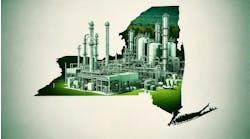Pumps, fans and compressors together consume between 50 and 85% of the total purchased energy in processing plants. Over-sized equipment and inefficient control schemes for these systems often lead to inefficiency and higher operating cost. In this case study, engineers at Owens Corning saved over $250,000/yr by optimizing several pumping, fan and compressed air systems serving its Santa Clara, Calif., fiberglass manufacturing plant.
[pullquote]
In 2007, an energy expert from the U.S. Department of Energy (DOE) assessed the plant's pumping systems and identified several opportunities to reduce energy use. The following four recommendations, once implemented, could significantly increase pump operating efficiency and reduce energy use for a combined annual energy savings of $122,000:
1. Trim the impeller or replace the pump on a treated water system with a more optimally sized unit, improving pump efficiency from the current level of 56%.
2. Replace the pressure reducing valve with a variable speed drive (VSD) on another treated water system. This system at times had intermittent excess flow directed to the sump through a bypass line. A VSD would regulate the pump to optimize the required flow rates and energy consumption.
3. Install more optimally sized pumps for the systems serving the wash water spray process and the binder lines.
4. Retrofit the pump serving the industrial water supply with a smaller unit fitted with a VSD to lower energy use and eliminate excess flow.
In addition, the assessment recommended periodic evaluations of pump efficiency, assessment of flow rates to reduce excessive flows and repositioning the tank discharge lines.
Realizing the likelihood of existing invisible energy losses in its centrifugal systems, plant personnel wanted some of the plant's fan and compressed air systems evaluated. In this assessment, the DOE found one centrifugal compressor didn't generate the amount of air it was rated for and was at the end of its useful life. The expert recommended replacing the compressor and maintaining a crossover valve that connected the main headers of both systems in the open position to allow the process system to support the main system. By taking these steps, the plant could save more than 2 million kWh annually. The assessments led to implementation of several energy-efficient upgrades, including installing variable frequency drives (VFD) on fans and upgrading the compressor.
Silicon Valley Power (SVP), the electric utility company of the City of Santa Clara, Calif., offers a rebate program as an incentive to customers who implement energy efficiency measures. The rebates are paid based on customers' actual reductions in energy use that result from well-designed energy efficiency projects.
Engineers from both the Santa Clara plant and SVP were eager to implement the recommended energy savings measures, but initial implementation costs were high — exceeding the 3-year corporate financial hurdle rate to qualify for project funding. Working with personnel at the Santa Clara plant, SVP helped make many of the projects more cost-effective with a series of strategic rebates. These rebates enabled plant engineers to replace the pressure-reducing valve with a VSD on the treated water pumping system, and install a VSD on the wash water spray process pump. The latter VSD not only reduced that system's energy use but also reduced a considerable amount of cavitation, enhancing equipment life. These implementations cost $22,000 with a $9,000 rebate from SVP, and resulted in annual savings of $67,000 with a simple four-month payback.
With the help of SVP, the Santa Clara project team implemented two other projects from the assessments. VFDs were installed on two Penclone fans and a large oven fan, saving $65,000 annually. With $32,000 in rebates from SVP, the plant recovered the $62,000-project cost in 11.5 months. The plant replaced its aging compressor, costing it $244,000 after getting rebates of $211,000 from SVP. With annual energy savings of approximately $120,000, the simple payback period was just two years.
Overall, SVP provided approximately $251,000 in rebates to the Santa Clara plant. These projects resulted in total annual energy savings across all three systems of $252,000. With implementation costs of $325,000, the plant achieved a 1.3-year simple payback. Strategic relationships between companies and utilities can lead to greater implementation of energy savings measures and result in a win-win situation for all.
Source: Project Fact sheet, Office of Industrial Technologies, Energy Efficiency, U.S. DOE
VEN V. VENKATESAN is Chemical Processing's Energy Columnist. You can e-mail him at [email protected]



